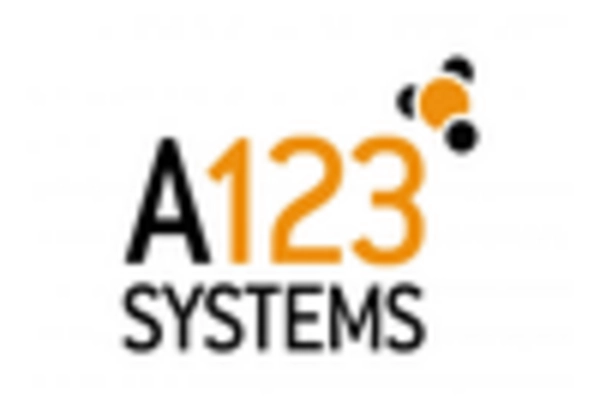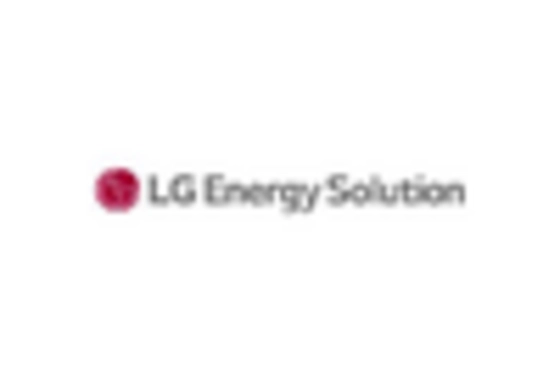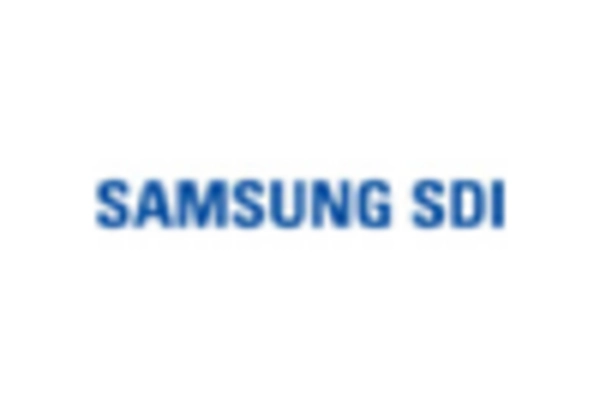Expansion of Consumer Electronics Market
The consumer electronics sector remains a formidable driver for the Lithium-Ion Battery Market. With the proliferation of smartphones, laptops, and wearable devices, the demand for compact and efficient batteries has intensified. In 2025, the consumer electronics market is expected to generate revenues exceeding 1 trillion USD, with lithium-ion batteries being the preferred choice due to their high energy density and lightweight characteristics. This trend suggests that as consumer preferences evolve towards more portable and powerful devices, the Lithium-Ion Battery Market will likely experience sustained growth. Furthermore, innovations in battery technology, such as fast charging and longer life cycles, are anticipated to further bolster this market segment.
Rising Demand for Energy Storage Systems
The escalating demand for energy storage systems is a prominent driver for the Lithium-Ion Battery Market. As industries and households seek to optimize energy consumption and manage costs, the need for effective storage solutions has become apparent. In 2025, the energy storage market is projected to grow at a compound annual growth rate of over 20%, with lithium-ion batteries being the preferred technology due to their scalability and efficiency. This trend indicates a shift towards decentralized energy systems, where lithium-ion batteries serve as a vital component in balancing supply and demand. The Lithium-Ion Battery Market is thus poised for growth, as the integration of energy storage solutions becomes increasingly essential in various sectors.
Growth in Electric Vehicle Infrastructure
The development of electric vehicle (EV) infrastructure is a critical driver for the Lithium-Ion Battery Market. As governments and private entities invest in charging stations and related technologies, the adoption of electric vehicles is expected to accelerate. By 2025, the number of public charging stations is projected to exceed 1 million globally, facilitating the transition to electric mobility. This infrastructure expansion not only supports the growing EV market but also enhances the demand for lithium-ion batteries, which are integral to EV performance. The Lithium-Ion Battery Market stands to gain from this trend, as the need for efficient, high-capacity batteries becomes increasingly paramount in supporting the burgeoning electric vehicle ecosystem.
Increasing Adoption of Renewable Energy Sources
The transition towards renewable energy sources is a pivotal driver for the Lithium-Ion Battery Market. As nations strive to reduce carbon emissions, the integration of solar and wind energy systems has surged. These renewable sources often require efficient energy storage solutions, where lithium-ion batteries play a crucial role. In 2025, the energy storage market is projected to reach approximately 200 GWh, with lithium-ion batteries accounting for a substantial share. This trend indicates a growing reliance on lithium-ion technology to store energy generated from renewable sources, thereby enhancing grid stability and energy efficiency. The Lithium-Ion Battery Market is thus positioned to benefit significantly from this shift, as the demand for reliable energy storage solutions continues to escalate.
Technological Innovations in Battery Manufacturing
Technological advancements in battery manufacturing processes are significantly influencing the Lithium-Ion Battery Market. Innovations such as solid-state batteries and improved recycling techniques are emerging, promising enhanced performance and sustainability. In 2025, the market for advanced battery technologies is expected to reach 50 billion USD, driven by the need for safer and more efficient energy storage solutions. These innovations not only improve the lifespan and safety of lithium-ion batteries but also address environmental concerns associated with battery disposal. As manufacturers adopt these cutting-edge technologies, the Lithium-Ion Battery Market is likely to witness a transformation, characterized by increased efficiency and reduced production costs.
















Leave a Comment